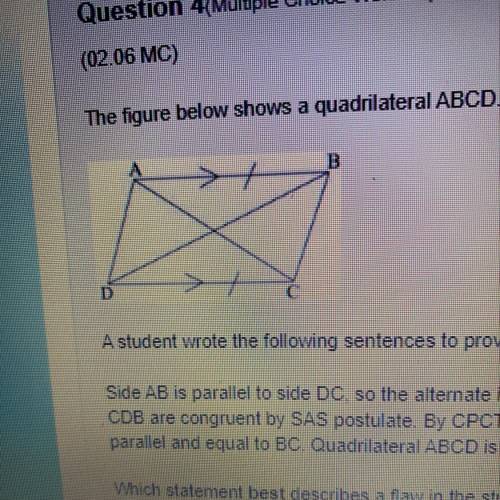
Mathematics, 29.06.2020 23:01 alliemmaddox
PLEASE I NEED HELPP !!
The figure below shows a quadrilateral ABCD. Sides AB and DC are equal and parallel
A student wrote the following sentences to prove that quadrilateral ABCD is a parallelogram
Side AB is parallel to side DC, so the alternate interior angles, angle ABD and angle CDB, are congruent Side AB is equal to side DC, and DB is the side common to triangles ABD and CDB. Therefore, the triangles ABD and
CDB are congruent by SAS postulate. By CPCTC, angles DBC and BDA are congruent and sides AD and BC are congruent. Angle DBC and angle BDA form a pair of vertical angles that are congruent. Therefore, AD is
parallel and equal to BC Quadrilateral ABCD is a parallelogram because its opposite sides are equal and parallel
Which statement best describes a flaw in the students proof?
O Triangles ABD and BCD are congruent by the SSS postulate instead of the SAS postulate.
Triangles ABD and BCD are congruent by the AAS postulate instead of the SAS postulate.
O Angle DBC and angle BDA form a pair of corresponding angles, not a pair of vertical angles
O Angle DBC and angle BDA form a pair of alternate interior angles that are congruent, not a pair of vertical angles


Answers: 2


Other questions on the subject: Mathematics

Mathematics, 21.06.2019 19:00, hiddenauthors436
Ineed to know the answer to this algebra question.
Answers: 1

Mathematics, 21.06.2019 19:30, MagicDragon4734
Which of the points a(6, 2), b(0, 0), c(3, 2), d(−12, 8), e(−12, −8) belong to the graph of direct variation y= 2/3 x?
Answers: 2

Mathematics, 21.06.2019 21:10, samtrevino9921
Which exponential function has an initial value of 2? f(x) = 2(3x) f(x) = 3(2x)
Answers: 1

Mathematics, 21.06.2019 23:00, britann4256
Calculate the average rate of change over the interval [1, 3] for the following function. f(x)=4(5)^x a. -260 b. 260 c. 240 d. -240
Answers: 1
You know the right answer?
PLEASE I NEED HELPP !!
The figure below shows a quadrilateral ABCD. Sides AB and DC are equal and p...
Questions in other subjects:

Mathematics, 04.02.2021 03:30


Mathematics, 04.02.2021 03:30



English, 04.02.2021 03:30



English, 04.02.2021 03:30

Mathematics, 04.02.2021 03:30



